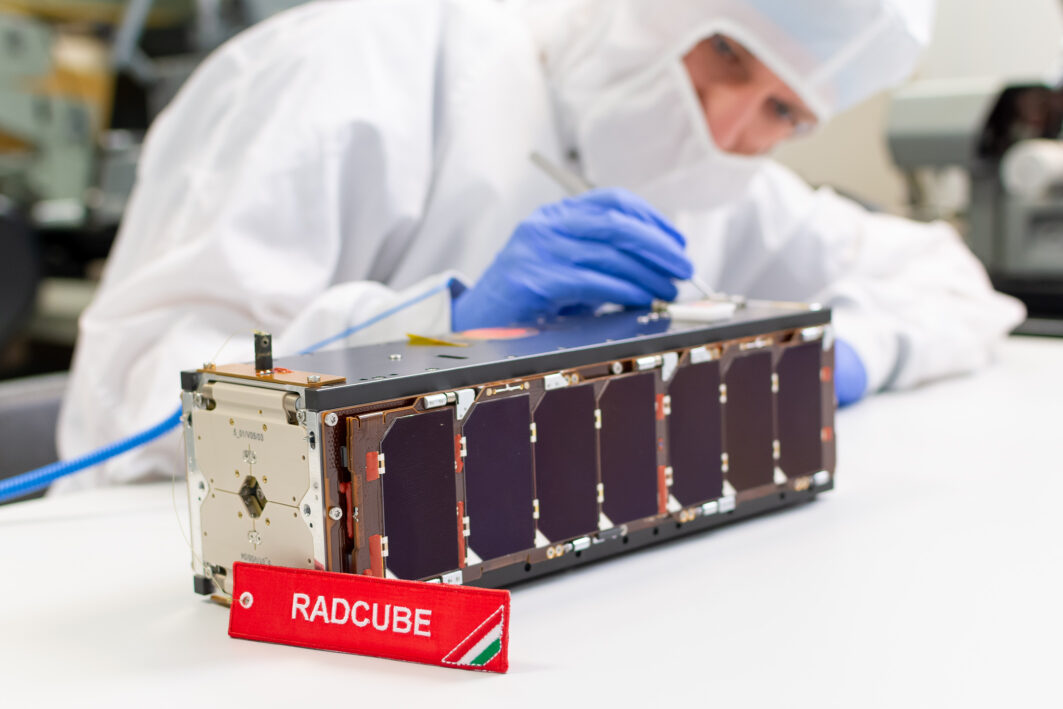RadCube mission’s commissioning phase has come to an end and the satellite keeps on fulfilling its duties for almost four months. In the RadCube mission, the satellite platform developed by an industrial actor for the first time in Hungary has gained flight heritage. Moreover, this is the largest one among the self-standing spacecraft orbiting with Hungarian ensign and has been developed by domestic engineers.

Budapest, Hungary — 17.12.2021 The commissioning phase of the RadCube 3U CubeSat has been successfully completed. The platform developed by C3S has been operating since its launch on 17 August 2021 and RadCube performs flawlessly under the extreme conditions of the space environment. After launch, the solar panels opened, and the electrical power system is properly charging the battery. The battery’s voltage and temperature are also stable. As indicated by the continuously downlinked telemetry data, the power switches of the subsystems operate well, and the thermal conditions of the subsystems are also nominal. Due to the communication between the On-board Computer (OBC) and the Mission Operations Centre, the C3S team receives the telemetry data several times per day when the satellite passes over the ground station in Budapest.
One of the commissioning phase’s milestones was the deployment of the boom that allowed the performance of scientific experiments 80 centimetres away from the satellite, this way minimizing its magnetic field. Following the deployment, the first measurement data arrived. Even before all of this, the company had started the collection of the housekeeping data of the primary scientific payload RadMag that was developed by the Centre for Energy Research. Approaching the end phase of the commissioning schedule, the activation of the instrument has been fully completed. During commissioning, the radiation unit of RadMag already recorded the effects of a space weather event.

C3S is the prime member of the ESA’s RadCube consortium and, besides holding the project together and adding technological value, its activity encompasses the entire lifecycle of the mission from mission planning, system engineering, platform design & development, through tests and simulations to the arrangement of the launch. Furthermore, its in-house developed Mission Operation Centre and the ground stations support the satellite’s operation after launch. Besides the Hungarian Centre for Energy Research, which is responsible for the space radiation environment monitoring payload, further members of the consortium are the Imperial College of London that developed the magnetometer payload, Astronika from Poland, which is liable for the boom mechanism, and ESA that provided the secondary payload to characterize space radiation effects on computer memory chips. Spanish DHV Technologies delivered the solar panels while the Belgian KU Leuven has provided the Attitude Determination and Control System (ADCS).
The satellite was launched from Guyana Space Centre, Kourou, French-Guyana with the coordination of Arianespace. C3S 3U CubeSat’s launch partner was SAB Launch Services Srl. The launch vehicle was a VEGA (flight VV19), a European launch vehicle. ESA contracted for a half year of operation in order to complete the In-Orbit Demonstration mission objectives. However, the design lifetime of the C3S satellite platform in space exceeds this several times over.
“The all-new CubeSat platform and the precision of RadCube’s miniature instruments demanded a complex commissioning process, which has now been successfully completed,”
explains Dorottya Milánkovich, C3S Project Manager.
RadCube is the sixth among the nanosatellites launched in low Earth orbit for technology in-orbit demonstration purposes within the ESA’s General Support Technology Programme (GSTP). The European Space Agency has brought several projects to life in recent years with the purpose of exploiting the immense and diverse potential of CubeSats. RadCube was funded from the GSTP contributions of Hungary, Poland and the United Kingdom.
“Now we have a fully functioning spacecraft with a well-running ground segment, which is capable of operating the scientific instruments, and hence contributes to a better understanding of our space weather environment, as well as giving important flight heritage to the newly developed technologies on board,”
explains Roger Walker, Head of the CubeSat Systems Unit, at the European Space Agency.
About C3S
C3S LLC’s (www.c3s.hu) products and solutions support both scientific experiments and space industry demands throughout the missions. The company’s mission planning activity encompasses highly reliable nanosatellite platform and subsystem design, prelaunch simulation software and hardware development and mission operation environment development. Its redundant subsystems are highly available and have a long life-cycle. Beyond CubeSats, C3S has an increasing presence in the medium satellite market as a designer of electric power distribution systems and payload management systems.
About RadCube Mission
The RadCube mission, created with the aim of technological demonstration, is carried out in the frame of an international consortium, which is led by C3S as the prime contractor, by the commission of ESA. The Centre for Energy Research, a subcontractor of this project, is responsible for the development of a space radiation measuring device placed inside a space weather monitoring equipment, which will serve as the payload on-board the platform. Further subcontractors are the Imperial College of London, developing the magnetometer and the Polish Astronika. The European Space Agency, being the customer in this project, also provides the secondary payload.
The spacecraft, that was born under the European Space Agency (ESA) General Support Technology Programme’s (GSTP) RadCube mission, is the first industrial satellite being built in Hungary, and so far, the largest as well. The in-house developed, high-reliability nanosatellite that is equipped with redundant subsystems will be sent into Low Earth Orbit.


 Copyright 2023 All rights reserved.
Copyright 2023 All rights reserved.